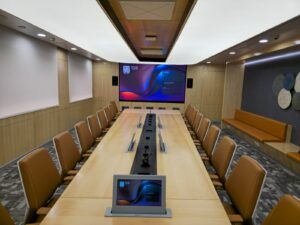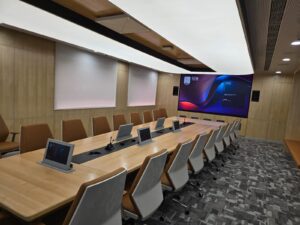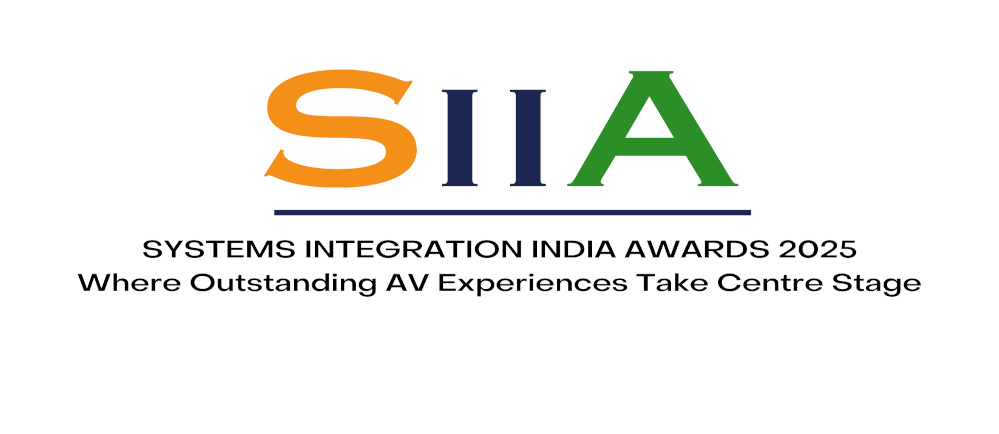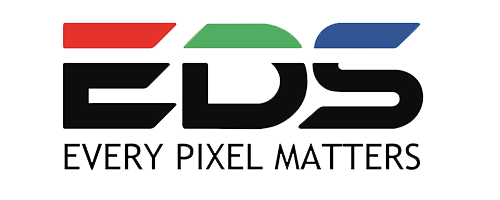BUDGET: Between 1 crore INR and 4.99 crore INR (More than USD135,000 but less than USD540,000)


Project Overview
This state-of-the-art AV integration project redefined the client’s corporate boardroom by transforming it into a next-generation collaboration hub. This executive boardroom AV integration redefines hybrid collaboration through seamless automation, adaptive design, and high-performance components. Engineered around Crestron’s ecosystem and amplified by QSC, SENNHEISER, SOLTEC, and Unilumen technologies, the solution delivers immersive conferencing across platforms. A central 136″ Unilumen LED wall provides visual clarity, supported by DM NVX encoders and SOLTEC retractable monitors. The Crestron One Beyond solution introduces voice-activated multi-camera switching via the Automate VX Pro system and P20 PTZ cameras—bringing dynamic speaker framing to hybrid meetings. Dual occupancy sensors enhance automation, enabling lighting and AV readiness with responsive control powered by the CP4N processor. Horizon keypads, DALI lighting, FlipTop cubbies with HDMI, USB-C, and CAT6 modules ensure intuitive interaction. Teams and the Zoom platform support ensure versatility. From sleek rack layouts to cable management and signal flow optimisation, this deployment sets a benchmark for AV excellence.
What did the client want to achieve?
The client sought a transformative boardroom experience that could support high-level hybrid meetings with seamless platform integration and executive-grade presentation clarity. Their goals included minimising user complexity, eliminating manual camera control, and enabling intelligent automation triggered by presence and interaction. They wanted a setup that felt intuitive yet sophisticated, with rapid switching between Teams and Zoom environments, clear audio capture across the room, and clutter-free BYOD flexibility. The visual infrastructure had to support decision-making with cinematic clarity, while ensuring the space remained sleek, modern, and free of visible hardware. The solution had to scale with future needs while remaining stable, secure, and effortless for users of varying technical comfort. “Above all, they envisioned a space that would empower every meeting to run with precision, presence, and professionalism—regardless of who was in the room.”
Scope of work your company was involved in
The project scope encompassed integration—from BoQ translation and rack layout design to onsite commissioning, testing, and award documentation. Our team led hardware selection and validated functional compatibility across audio, video, control, conferencing, and automation domains. Rack layout and signal flow diagrams were optimised to align with physical constraints and cable lengths, ensuring efficiency and serviceability. We implemented occupancy-based automation, coordinated DALI lighting integration, and tuned DSP settings for audio clarity. Camera positioning and presets were configured to maximise One Beyond tracking, enabling dynamic speaker framing. FlipTop modules were mapped to common BYOD scenarios. Configuration and control workflows were tailored to minimise clicks, enabling seamless launch of Teams or Zoom meetings. All control logic, device integration, and interface automation were programmed within the Crestron CP4N environment using SIMPL and custom scripting modules—ensuring unified performance across platforms. Post-installation testing included latency analysis, acoustic calibration, lighting response verification, and failover simulation. Final documentation included user guides, system architecture, and submission narratives.
What Key Challenges were faced?
The client’s architectural constraints limited mounting flexibility, making camera sightlines and ceiling mic placement a critical design obstacle. Avoiding visible cabling while preserving complete signal integrity across USB, HDMI, and Dante paths was another challenge—especially with retractable displays and cable cubbies. The requirement to switch dynamically between Teams and Zoom added complexity to control logic and UI design. Accommodating dual occupancy zones with separate automation triggers required custom logic mapping within the control processor. The LED wall’s pixel pitch and resolution had to be matched with input scaling to avoid distortion. Ensuring enough PoE availability across devices in the rack without performance degradation demanded thoughtful switch and power supply specifications. A significant technical challenge arose during sensor calibration—occupancy sensors were falsely triggered due to HVAC airflow, leading to unreliable automation activation.
How were those challenges resolved?
To resolve mounting limitations, we used precision modelling to simulate camera angles and optimised ceiling mic tiles using beam coverage software. Custom brackets and fine-tuned presets enabled reliable One Beyond tracking. Cable routing was handled via under-table cloaks, cubby retractors, and shielded conduit runs to preserve aesthetics and signal quality. Platform switching was achieved through Crestron Flex kits, programmed for single-touch launch with backend logic. Dual occupancy zones were mapped via CP4N scripting to trigger independent lighting and AV sequences. Dante and HDMI scaling challenges were addressed using NVX encoders and EDID profiles. PoE distribution was stabilised using CEN-SWPOE-48 and DIN-PWS60 devices. To mitigate HVAC-triggered false occupancy signals, we repositioned the Crestron CEN-ODT-C-POE sensors and adjusted detection angles. Acoustic panelling was installed behind the AV rack to absorb ambient noise and interference—restoring reliable sensor performance and automation triggers. APIs across QSC, Crestron, and AirMedia platforms were unified via custom modules for a consistent user experience.
How has your work helped the client
The solution radically simplified the client’s conferencing experience. With voice-activated camera tracking and dynamic switching, meetings became immersive and frictionless—no manual inputs or technical support required. Occupancy-driven automation reduced energy consumption and ensured readiness when participants entered either zone. The LED wall’s sharp imagery improved visual engagement. At the same time, seamless BYOD access enabled quick content sharing—the control interface aligned with their workflow, empowering users to switch between Teams and Zoom with confidence. The retractable monitors decluttered the table without sacrificing access. Audio performance saw a measurable improvement in clarity and echo cancellation, supporting decision-making during critical meetings. Technical reliability reduced downtime, while proactive feedback from users affirmed adoption and ease-of-use. The client now uses the space to host executive briefings and global partner collaborations, setting a new standard across their facilities.
What are you most proud of about the project?
We’re proud of engineering a truly intelligent AV environment that feels effortless to the end user while managing enormous behind-the-scenes complexity. Integrating Crestron’s One Beyond system with occupancy-driven automation and multi-platform conferencing without compromising design elegance was no small feat. Every element—audio pickup, camera framing, retractable displays, BYOD access—responds harmoniously, creating a fluid user experience that adapts to context. We transformed a vision into a scalable, award-worthy reality that balances function, precision, and form. “It’s not just a room—it’s an ecosystem where technology anticipates intent, and innovation meets intuitive control.”
Video: https://youtu.be/dNVXijsVH-s












